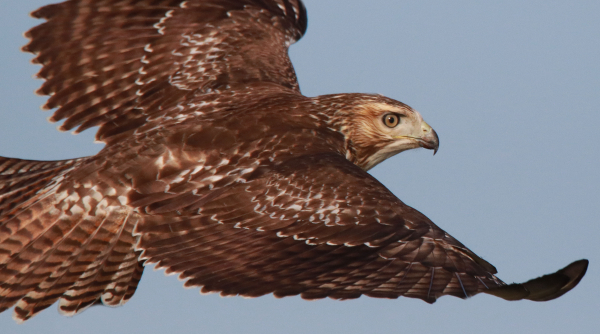
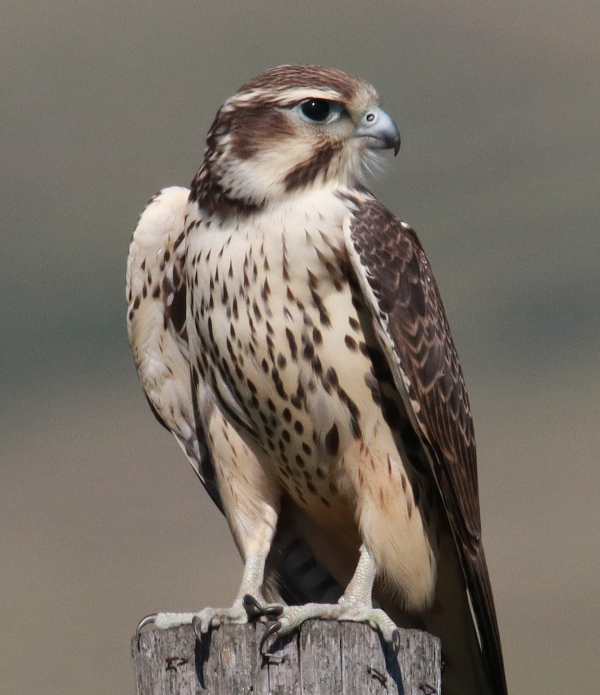
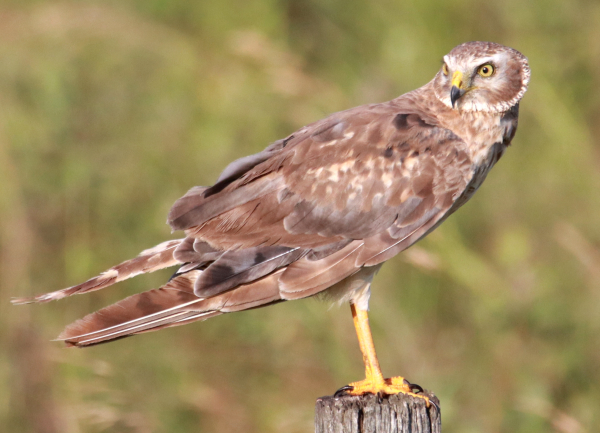
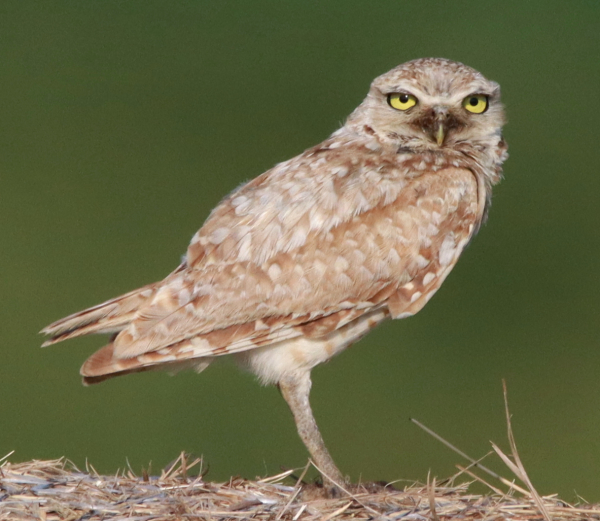
An sun-bleached Burrowing Owl was an especially rare find close to home, and the location represents the farthest east I have seen a Burrowing Owl in the Great Plains. This owl was beginning to molt too, as indicated by some new primary wing feathers.
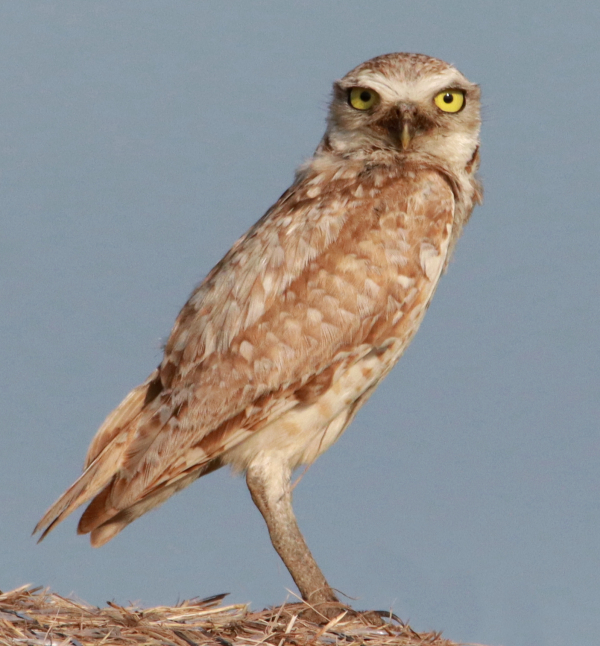
Compared to the owl photo with the dark green background, this image provides a completely different look for the Burrowing Owl, taken when I positioned lower to use the clear blue sky as a background while the owl stood taller. It’s quite obvious that some birds are on the move after the nesting season.
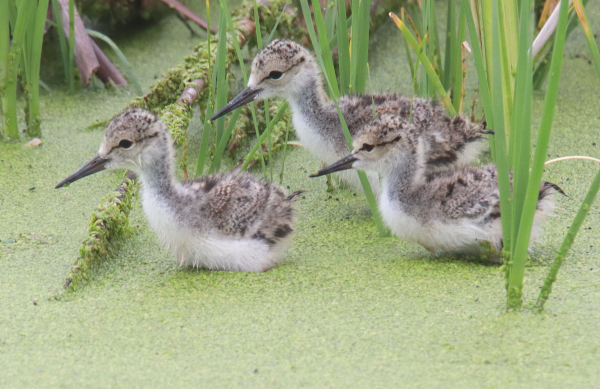
Especially cute and vulnerable, 3 of 4 newly hatched Black-necked Stilts were an obvious highlight of an unplanned visit to Hecla Marsh. For some reason, the attentive adults led the hatchlings toward me, then past me (thank you very much).
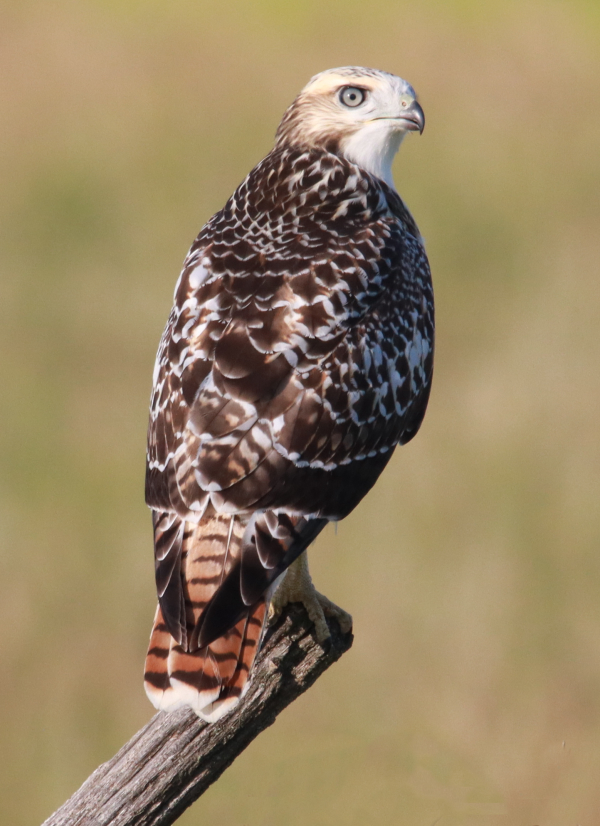
A recent fledgling Red-tailed Hawk was observed in a traditional nesting territory about 10 miles south of the office, this one showing very adult-looking orange-colored tail feathers rather than the usual tan-brown tail feather coloration. Nonetheless, the fledgling acted very fledgling-like while hunting on the ground and interacting with large insects.
|
Last week really showed a mixture of natural history, behavior, and physiology elements among the birds in my area of the northern Great Plains. There were still new hatchlings breaking out of their eggs, while nestlings were fledging, newly independent birds were learning where and how to find food and becoming better fliers, many species were molting, some birds were beginning to form flocks, recent migrants were arriving from the Arctic and boreal forests while others were arriving from mountains, badlands, prairies, or eastern woodlands. Birds ranging from shorebirds, raptors, songbirds, hummingbirds, and even an owl created new avian sightings and insights – it was truly exciting day to day!
After seeing the Carolina Wren in my yard the previous Sunday (only the 3rd documented sighting in North Dakota) I was again surprised last Thursday afternoon when I saw a falcon along my regular Raptor Route. After a chance to take photos of the female and male Ferruginous Hawks perched in their nesting territory, 5 miles farther north a Prairie Falcon materialized – a species I don’t get to see every year in this state. It was very trusting, somewhat curious, and it permitted me to photograph it at will during an extended observation period of more than 5 minutes.
It was a beautiful bird, without a blemish or speck of dirt on its new plumage, and its feet and bill were unstained by feeding. The falcon was obviously a newly independent recent fledgling, perhaps a month out of the faraway nesting eyrie where it was raised – perhaps in Alberta or Montana, possibly from the Badlands of the western Dakotas. Considering its smallish size, I thought it was a male until I saw the size of its feet, so large that it must be a female. It’s status as a newly independent bird was verified by the pale blue-gray coloration of its upper beak and adjoining cere, the orbital skin around its eyes, and its legs and feet (these body parts are yellow in older Prairie Falcons).
I so enjoyed observing this fine example of a falcon, and photographing her was a delight, although she did little more than turn this way and that on the post where she stood, but that was plenty to keep me interested in spending some time in her company. I share a photograph with you here, and you can see several more in the second article in this issue, along with more of a description about this encounter. In the end, something seemed to catch her eye behind her perch, and she reversed her stance and dived into a low flight behind the tall hill and I was never able to relocate the surprise Prairie Falcon.
During the following 2 nights I retraced my drive along the Raptor Route, just in case the Prairie Falcon might linger in the area. I was a little surprised I didn’t see the Ferruginous Hawk pair or their fledglings on territory Friday evening, but there was a scattering of Swainson’s Hawks and a Krider’s Red-tailed Hawk, as usual. Toward the end of the rectangular route I sighted the first independent Red-tailed Hawk of the season. She was a big female, and I was able to take a few photographs of her as she was perched on a low post, and a couple more as she flew northward, one of which is the first illustration for this article.
Moments later, another raptor was perched in a similar fashion near the road – a Northern Harrier. It appeared to be a female with especially sun-bleached plumage, but when I had a chance to view the photographs I took of the harrier, it was interesting to see a few new gray feathers replacing the weathered brown feathers, most notably a couple of the primary wing feathers. Of course, this indicated the hawk was a young male molting into adult male plumage! The photograph I selected to illustrate this molt is also interesting because the wind was blowing the specialized feathers at the rim of the hawk’s facial disc, which emphasizes this interesting owl-like feather adaptation among the world’s harriers.
The following early evening, Saturday, I drove the Raptor Route again, without seeing either of the Ferruginous Hawks again, which is suggestive that they and their fledglings have left their nesting territory and initial post-fledging area to occupy another location beyond my view, perhaps far beyond it. Swainson’s Hawks provided some photo opportunities, and as I approached the end of the route, I spied a smallish, tan-colored bird from a distance – larger than a meadowlark but smaller than a hawk – maybe another falcon? Actually, rarer yet!
I was especially surprised to see a Burrowing Owl perched atop a large haybale and quickly tried for a documentary photo or 2. The small off-color owl was not concerned but was aware of the white car that parked nearby. It was immediately obvious this bird had seriously weathered, sun-bleached plumage head to legs. I have studied Burrowing Owls during most of my career, but I have never seen one with such damaged plumage. That said, this bird was most likely originating from a location much farther to the west, northwest, or southwest. It was now perched at the eastern edge of the species range, and I have only seen 1 Burrowing Owl east of the Badlands in the far west of Dakota in 2 decades, and that was the individual I reported and photographed at Long Lake National Wildlife Refuge in May.
The owl was trusting enough to permit me to photograph it with a dark green background (a tall green cornfield), and with a blue sky background, which required me to reposition on the ground. When I was standing tall, the owl stood tall too, and at one point it even called, which delighted me – it has been so long since I heard the characteristic call of the Burrowing Owl. It also made me back away and return to my car before the owl reacted more. Then, as I prepared to start the engine and drive away, I heard the call again and looked up to see the owl flying in a half-circle above me, low, and angling north to land atop an old haystack not far from the road. One, it was exciting, partly just to see that the owl could fly well considering its battered plumage, but also to know that it remained in the area. When I checked the photos I took that evening, I could see the Burrowing Owl was beginning to molt its battered plumage with a few new primary wing feathers intact already.
Beyond the Raptor Route
After a dentist appointment within 20 miles of Hecla Marsh, how could I resist heading across the border to the Dakota to the south. It is a place where I can regularly see Black-necked Stilts and a variety of other birds that aren’t commonly encountered elsewhere as a group. The highlight was a newly hatched brood of 4 downy stilt hatchlings, and while I expected the adult pair to hide them away, I was surprised that they actually led the downy young ones toward me, slowly, feeding along the way. I eventually had a great opportunity to photograph them as the downy stilts edged together for me to get 2 to 4 of them in the photo frame at a time. I hoped to also get a photograph of a young one with an adult, but the adults seemed preoccupied and didn’t hover over the hatchlings. Overall, I observed 2 pairs of stilts and a single adult, plus the 4 hatchlings.
In the marsh there were also a few Gadwall broods, many Blue-winged Teal and Mallards, a few molting Wood Ducks, Black Terns, Snowy Egrets, Great Egrets, White-faced Ibis, and about 30 American Avocets with very pale cinnamon color in their neck plumage, molting toward their basic plumage in a subtle way. Beyond the marsh, there was also a Red-headed Woodpecker, an adult Bald Eagle, 8 Wild Turkey gobblers, and some obvious mixed flocks of Bank Swallows and Barn Swallows numbering between 30 and 60. Similarly, some Yellow-headed Blackbirds were gathered in flocks too.
During a birding trip to Bismarck last Thursday, I cruised through Long Lake National Wildlife Refuge, McKenzie Slough, and Dog Town Marsh – all excellent birding hotspots with different combinations of species to see. Long Lake had the usual White Pelicans and Western Grebes, although the Western Grebe scene was much subdued this year with only a few single young grebes obvious. A few Mallard, Gadwall, and Blue-winged Teal broods were on hand, and Spotted Sandpipers were scattered along lake shores. Two large flocks of swallows were obvious, one with Bank and Barn Swallows, the other with mostly Cliff Swallows and a few Barn Swallows.
McKenzie Slough was filled with Eared Grebes – pairs with young hatchlings that created a constant high-pitched food-begging call in the background, and there were several Western Grebes. Ruddy Ducks were the most obvious ducks with a scattering of Mallards, Northern Shovelers, Blue-winged Teal, and a few Northern Pintails. White-faced Ibis were mostly seen in flight due to the tall cattails throughout much of the wetland. At McKenzie and Long Lake, there were obvious flocks of Yellow-headed Blackbirds forming now that their nesting season is complete. The smaller area of Dogtown Marsh was quite active with ducks, with a fairly mature brood of 8 Redheads with a nearly white-headed female a standout, plus a couple broods of Mallards and Blue-winged Teal, but no newly hatched broods. There were also molting Wood Ducks and a group of Ruddy Ducks, more Redheads, and a few White Pelicans and molting Franklin’s Gulls and Ring-billed Gulls.
Closer to home, about 60 Long-billed Dowitchers have been pretty standard this week at Bobby’s Bay along with a few Stilt Sandpipers and Lesser Yellowlegs, plus the maturing mega-brood of Gadwalls, numbering 17 the last time I counted. My impression that there were few new duck broods hatching recently was smashed when I drove south Sunday evening and saw 2 newly hatched Mallard broods, 1 new Gadwall brood, and a new Ruddy Duck brood. I also found a newly fledged Red-tailed Hawk near the annual nest site close to my friend Herb’s ranch. I watched and photographed as the attractive fledgling was hunting on the ground along both sides of the rural gravel road. The unusual thing about this newly fledged hawk was its bright orange tail feathers, which at one point made me think twice about whether it was a fledgling or not (see the last photo). A point of Sunday excitement was seeing the first Semipalmated Plover to return from nesting in northern Canada or Alaska, and seeing a brood of 7 Ring-necked Pheasants with a hen within a mile of home was exceptional.
Hummingbirds & Orioles
Wednesday evening the first fledgling Ruby-throated Hummingbird drank from my feeder, and an hour later a female arrived – the first in July – and she seemed to be gorging on nectar considering how long she drank and drank. Later, a male appeared, and after a couple sips it flew upward, flashing its gorget bright ruby-red, even in the low light of sunset. Hummingbird sightings continued Thursday when a male stopped in during my short observation period, but it was Sunday noon before a molting male visited the feeder. This male was missing feathers on its back, breast, and upper wings, which I noticed when using my binoculars. With that information I could identify it if he returned – and he did. A different male visited the feeder near sunset, and Monday afternoon a new identifiable female drank a volume of nectar, returning at 6pm as I continued my office work.
Male and female Orchard Orioles continue to be the featured visitors to the grape jelly feeder, along with American Robins and House Finches. An especially bright red male House Finch has recently been a standout among the finches, beaming red any time he arrives at the feeding station. And a colorful male American Goldfinch perched above the feeders and water basin for a moment Sunday afternoon, but it was the only different songbird to appear when I was present to see feeder visitors last week.
Even so, it is clear that several different species are on the move, repositioning like the Prairie Falcon, Burrowing Owl, and Carolina Wren. What birds will show next? Keep alert for new bird sightings in your yard and the surrounding area, as well as any favorite birding hotspots you visit. Enjoy the days of August ahead!
Article and Photos by Paul Konrad
Share your bird sightings and photographs at editorstbw2@gmail.com